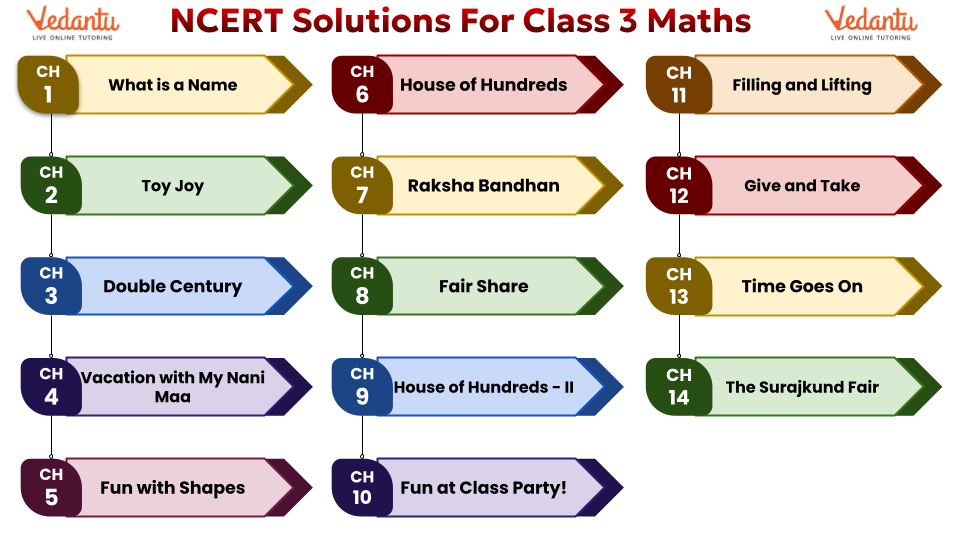Chapter-wise Class 3 Maths Questions and Answers Free PDF Download
FAQs on NCERT Solutions For Class 3 Maths All Chapters - 2025-26
1. Where can I find accurate and easy-to-understand NCERT Solutions for all chapters of Class 3 Maths?
You can find comprehensive and reliable NCERT Solutions for Class 3 Maths for all chapters right here on Vedantu. These solutions are prepared by subject experts and provide step-by-step answers to every question in the NCERT textbook, aligning with the 2025-26 CBSE curriculum.
2. What topics are covered in the NCERT Solutions for Class 3 Maths?
The NCERT Solutions for Class 3 Maths cover the entire syllabus. Key topics for which solutions are provided include:
- Where to Look From
- Fun with Numbers
- Give and Take
- Long and Short
- Shapes and Designs
- Fun with Give and Take
- Time Goes On
- Who is Heavier?
- How Many Times?
- Play with Patterns
- Jugs and Mugs
- Can We Share?
- Smart Charts!
- Rupees and Paise
3. Are the NCERT Solutions for Class 3 Maths available as a free PDF?
Yes, Vedantu provides NCERT Solutions for Class 3 Maths in a PDF format, which can be accessed for free. This allows students to use the solutions offline to practise questions and clarify doubts anytime, ensuring they have the resources needed to excel in their studies.
4. How do the step-by-step methods in these NCERT Solutions help in understanding difficult concepts like division?
The step-by-step methods break down complex problems into smaller, manageable parts. For a topic like division (in the chapter 'Can We Share?'), the solutions don't just give the final answer. They show the correct method of repeated subtraction or grouping, which helps build a strong conceptual foundation and problem-solving skills, as per the CBSE guidelines.
5. Why is it important to follow the method given in the NCERT Solutions instead of just finding the correct answer?
Following the prescribed method is crucial because teachers evaluate the steps you take to arrive at an answer, not just the final answer itself. Using the correct solving methodology as shown in the NCERT solutions ensures you learn the right approach, which helps in scoring full marks in exams and builds a strong logical thinking process for future classes.
6. How can I use Vedantu’s NCERT Solutions effectively if I am stuck on a problem in a chapter like 'Jugs and Mugs'?
If you are stuck on a problem about capacity in 'Jugs and Mugs', first try to solve it on your own. Then, refer to Vedantu's NCERT Solutions to compare your method with the expert-solved answer. Pay close attention to the step-by-step explanation to understand where you went wrong. This approach helps in self-correction and deepens your understanding of the concept.
7. Do these NCERT Solutions cover every single question from the Class 3 Maths textbook?
Yes, our NCERT Solutions are exhaustive and cover every single question from all the exercises in the Class 3 Maths textbook. This includes in-text questions, end-of-chapter problems, and any puzzles or activities that require a mathematical solution, ensuring complete coverage of the syllabus.
8. Are these solutions updated according to the latest CBSE 2025-26 syllabus for Class 3 Maths?
Absolutely. All our NCERT Solutions for Class 3 Maths are carefully reviewed and updated to be in complete alignment with the latest CBSE 2025-26 syllabus and NCERT guidelines. Students can rely on these solutions for current and accurate academic content.
9. Beyond just getting answers, what is the main benefit of using NCERT Solutions for a chapter on multiplication like 'How Many Times?'?
The main benefit is learning the 'why' behind the 'how'. For the chapter 'How Many Times?', the solutions don't just provide multiplication facts. They explain multiplication as repeated addition and demonstrate how to solve word problems systematically. This builds problem-solving skills and shows how mathematical concepts apply to real-world situations, which is a key goal of the NCERT curriculum.

























